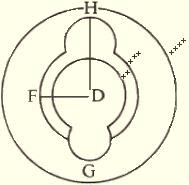Francisco de Goya y Lucientes , Perro Semihundido.
Psychotic depression is melancholia
Approximately one-third of melancholic patients are psychotic. Psychotic features in melancholia are reported at all ages, although the recognition of psychotic depression increases with the patient’s age. In some reviews nearly all patients with psychotic depression are melancholic.
In nineteenth-century psychopathology, disorders of thought were identified in patients classified as manic-depressive insanity, involutional and melancholic depression, dementia praecox, and dementia paralytica (neurosyphilis). Psychosis was not pathognomonic for any condition. During the early and mid twentieth century, however, ‘‘first-rank’’ psychotic features (e.g., complete auditory hallucinations, experiences of alienation and control) were associated with the hereditary disorder of dementia praecox, later redefined as ‘‘schizophrenia.’’ The presence of these signs was considered pathognomonic of schizophrenia regardless of the presence of a concurrent mood disorder.
The view that schizophrenia encompassed almost all episodes of psychosis was favored in the USA but not in Europe. Cross-Atlantic diVerences in the prevalence of schizophrenia and of manic-depressive psychosis were reported, and to assess the basis for the discrepancy, a cross-national group of investigators examined patients in the UK and in the USA. Differences in diagnostic perceptions, not national distinctions in populations, best explained the differences in prevalence of the disorders. The broad definition of schizophrenia in the USA materially increased the numbers of patients who were labeled schizophrenic while reducing the
numbers diagnosed with mood disorders.
The place of psychotic mood disorder in psychiatric classification remained unclear. Some considered these states to be more severe forms of manic-depressive illness while others preferred to define them as ‘‘schizoaVective’’ and to include them among the psychotic disorders. One understanding of psychosis in patients with mood disorders derived from the clinical trials of TCAs. Among depressed hospitalized patients treated with imipramine with serum blood levels monitored to assure adequate dosing, some patients failed to respond to imipramine but did respond to ECT. The presence of delusions discriminated the patients who had not improved with imipramine alone. A decade earlier, a large Italian study by De Carolis et al. (1964) had also reported that the psychotic depressed patients had not responded to imipramine but had recovered with ECT. The association between depression, psychosis, poor response to TCAs, and rapid response to ECTwas quickly confirmed and is now widely accepted.
The DSM classifications of 1980 and 1994 still give preference to psychotic features as defining schizophrenia, and they primarily link catatonia with schizophrenia despite its strong association with mood disorder. Psychotic features are recognized as a non-specific psychopathologic phenomenon, appearing within diVerent diagnostic classes, and delusions in a mood disorder are considered signs of severity, not distinctions in pathophysiology, but this classification is only permitted when directly linked to a disturbed mood state. If the patient has delusions that last longer than the mood symptoms or the psychotic features are deemed more pronounced, the schizoaffective diagnosis is preferred and the patient assigned to the psychotic disorders, not mood disorder, category. Nevertheless, for each principal mood disorder – major depressive disorder, bipolar I disorder, and bipolar II disorder, depressed type – the presence of psychosis could be recognized by coding the severity/psychotic/ remission specifier in the fifth digit.
Once a condition of ‘‘psychotic depression’’ or ‘‘delusional depression’’ was recognized, attention was paid to its delineation from other depressive illnesses. Focusing on the motor aspects of melancholia, Parker and Hadzi-Pavlovic (1996) envisioned three forms of depressive illness – psychotic depression, non-psychotic melancholia, and non-melancholic depression.79 They oVered criteria of discrimination by age of onset, degree of cognitive impairment, and prominence of personality and life events. Non-melancholic depression was characterized by early onset of illness, little cognitive impairment, deviant personality traits, and little psychomotor disturbance.
Severity of psychomotor disturbance and cognitive impairment characterized psychotic melancholia. Psychotically depressed patients exhibited more severe psychomotor disturbance, including facial immobility, slumped posture, slowed and limited movements and speech, poverty of associations, and poor responsiveness. Non suppression on the dexamethasone suppression test was recorded in 72% of the patients. The mood was characterized as ‘‘non-reactive.’’ While the distinction was clear between non-melancholic depression and the other two forms of depressive illness, psychotic and non-psychotic melancholia were not shown to be different diseases.
Other authors focused on abnormalities in neuroendocrine and neurocognitive measures, course of illness, familial transmission, and response to treatment as distinguishing psychotic and non-psychotic depression. Among the criteria were greater guilt feelings and psychomotor disturbances, biochemical differences in glucocorticoid activity, dopamine beta-hydroxylase activity, levels of dopamine and serotonin metabolites, severity of sleep measures, and ventricle-to-brain ratios.
Neuropsychological deficits were found to be greater in degree among psychotic depressed patients than among the non-psychotic depressed. None of these efforts identified a clearly distinguishing variable.
In a retrospective examination of patients in Denmark who had a diagnosis of a single depressive episode at their first ever discharge during the period 1994 through 1999, patients were identified as with or without the International Classification of Diseases, 10th edition (ICD-10) diagnosis of melancholia (n ¼ 248 and 293 respectively), and with and without psychosis (n ¼ 1275 and 1639, respectively).
Relapse rates were highest in the psychotic depression group. The groups did not differ in suicide rates or melancholic features. Compared to non-melancholic depressed patients, the melancholic patients were less likely to be diagnosed as having a personality disorder, stress-related disorder, or ‘‘nervous’’ disorder. It is diffcult to recognize the presence of psychosis in melancholic patients. The more severely ill depressed patients are common in referrals for ECT. In an analysis of ECT referrals, only 2/52 patients had been adequately treated for psychotic depression. The authors assumed that, had the referring physicians recognized the presence of psychosis, the medications prescribed would have been more appropriate for psychotic depression.
Other than the recognition of psychosis, no measures distinguish the psychotic and non-psychotic forms of melancholic illness.





